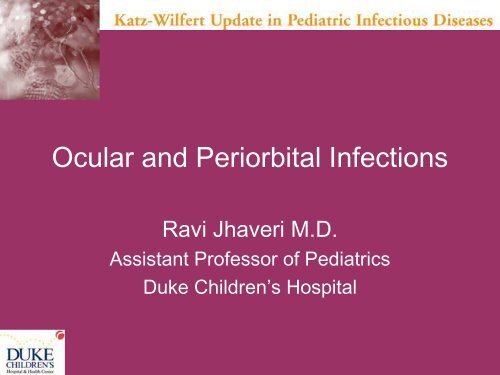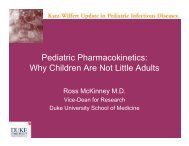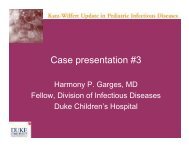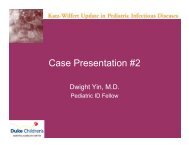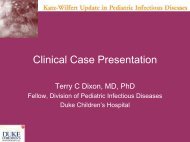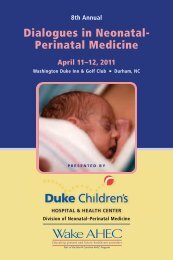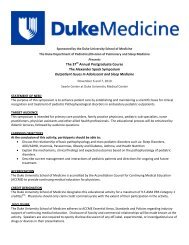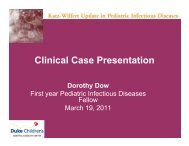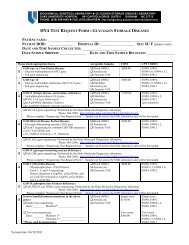Ocular and Periorbital Infections - Duke Pediatrics Intranet
Ocular and Periorbital Infections - Duke Pediatrics Intranet
Ocular and Periorbital Infections - Duke Pediatrics Intranet
You also want an ePaper? Increase the reach of your titles
YUMPU automatically turns print PDFs into web optimized ePapers that Google loves.
<strong>Ocular</strong> <strong>and</strong> <strong>Periorbital</strong> <strong>Infections</strong>Ravi Jhaveri M.D.Assistant Professor of <strong>Pediatrics</strong><strong>Duke</strong> Children’s Hospital
Objectives• Underst<strong>and</strong> the clinical presentation,etiologic agents <strong>and</strong> treatment of:– <strong>Periorbital</strong> <strong>and</strong> Orbital Cellulitis– Conjunctivitis– Keratitis– Retinitis– Optic Neuritis
<strong>Periorbital</strong> <strong>and</strong> Orbital Cellulitis• <strong>Periorbital</strong> cellulitis-infection of softtissues anterior to orbital septum• Different from Orbital, which extendsposterior to the septum <strong>and</strong> threatens:– spread directly to sinuses of the brain <strong>and</strong>cause severe sequelae– loss of vision by thrombosis of retinal arteryor destruction/compression of optic nerve
<strong>Periorbital</strong> <strong>and</strong> Orbital Cellulitis• Pathophysiology-– Contiguous spread from infected sinuses mostcommon• Ethmoid sinusitis is a major contributor to Orbital Cellulitis– Breaks through the Lamina Papyracea– Direct inoculation via trauma of overlying skin <strong>and</strong> softtissue
A schematic illustrating the relationship between the eye <strong>and</strong> theparanasal sinusesWald, E. R. <strong>Pediatrics</strong> in Review 2004;25:312-320Copyright ©2004 American Academy of <strong>Pediatrics</strong>
<strong>Periorbital</strong> <strong>and</strong> Orbital Cellulitis• Usual agents-– Staph. Aureus <strong>and</strong> GABHS from skin– Strep pneumo from sinuses, also respiratory aerobes,other anaerobes• No specific data post-PCV7 to show that incidence hasdecreased, but I suspect that it has• No specific data that MRSA has increased incidence, butmaybe• Less common-• HSV-characteristic vesicles should be present• Fungus in immunosuppressed (Zygomycetes are deadly <strong>and</strong>deforming!)
<strong>Periorbital</strong> <strong>and</strong> Orbital Cellulitis• Clinical manifestations:– <strong>Periorbital</strong> cellulitis usually associated with:• swelling of the eyelid• discoloration of the orbital skin, redness, <strong>and</strong>warmth.• Conjunctival ecchymosis <strong>and</strong> injection withoccasional discharge, fever, <strong>and</strong> leukocytosis areseen.• Vision, extraocular movements, pupillaryfindings, <strong>and</strong> optometric examinations arenormal
<strong>Periorbital</strong> <strong>and</strong> Orbital Cellulitis• Orbital cellulitis tends to have similar butmore severe symptoms than preseptalcellulitis–Proptosis– decreased ocular mobility– ocular pain– tenderness on eye movement.
<strong>Periorbital</strong> <strong>and</strong> Orbital Cellulitis• Diagnosis:– Good history with attention to presentingsymptoms, risk factors in past medical history– PE must assess extraocular muscles <strong>and</strong> visualacuity-if the lid is swollen <strong>and</strong> you can’t see, callsomeone who can!!!– CT scan of orbit is test of choice-to assessinvolvement of orbital structures, presence of subperiostealabscess that needs drainage, R/O tumorif in doubt
<strong>Periorbital</strong> <strong>and</strong> Orbital Cellulitis• Treatment:– For <strong>Periorbital</strong>/Orbital cellulitis, few keys areparamount:• Prompt initiation of appropriate antimicrobial therapy-–2 nd /3 rd generation cephalosporin, +/- clindamycin,vancomycin are mostly likely choices» Need to worry about MRSA nowadays• Prompt referral for consultation of proper surgical service:ENT, Ophthalmology, Oculoplastics, whoever!– Surgery used to be m<strong>and</strong>atory, but that has changed• Frequent reassessment-if no surgery soon, maybe neededlater
Orbital Cellulitis outcomes• Nageswaran et al at Wake Forestreviewed 41 cases of Orbital Cellulitisover 10 years• Mean age 7.5 years• 40 children had ethmoid sinusitis• Conservative management performedwell, shorter stays than those to OR• Patients treated for 21 days withantibioticsNageswaran et al, PIDJ 2006 Aug;25(8):695-9.
Orbital Cellulitis outcomesNageswaran et al, PIDJ 2006 Aug;25(8):695-9.
<strong>Periorbital</strong> <strong>and</strong> Orbital Cellulitis• Keys to remember-– If symptoms are concerning, really need to checkvisual acuity <strong>and</strong> EOM to r/o orbital cellulitis– Prompt therapy will help prevent vision loss– Surgery may be needed at some point so transfer toget the appropriate team involved early
Conjunctivitis• Inflammation of the mucous membrane,which extends from lid margin to sulcus(palpebral) <strong>and</strong> sulcus to corneal limbus(bulbar)• Can be together or separate frominfections of cornea (keratitis)
• Symptoms include:Conjunctivitis– affect one or both eyes.– red, injected (hyperemic) conjunctiva– discharge that is watery or purulent– Matted eyelids are common.– Pseudomembranes may be present• they do not bleed when removed– True membranes as well• these are fibrin coagulated exudates attached toinflamed conjunctiva, which bleed if removed
Conjunctivitis• Bacterial agents to consider:– Gonococcal conjucitivitis• neonate in first 2-5 days after birth• Copious purulent discharge from the eye• Concerning for corneal ulceration withpermanent damage <strong>and</strong> systemic spread• Diagnosis by gram stain (GN2C) <strong>and</strong> culture• Patients need systemic antibiotics <strong>and</strong> copiousirrigation with monitoring of the cornea
Conjunctivitis• Bacterial agents to consider:– C. trachomatis– first two weeks, days 4-15– less discharge than GC, more watery withpseudomembrane– usually cough develops later– Therapy consists of topical <strong>and</strong> systemicantibiotics
Conjunctivitis• Bacterial agents to consider:– Other bacterial causes:• P. aeruginosa-preterm infants with bacteremia• H. influenzae– associated AOM 70-80% of the time• S. pneumoniae– Significant portion are non-typable (unencapsulated)• S. aureus• L. moncytogenes-farmyard dust, farmer’s eye• B. burgdorferi
Conjunctivitis• Viral agents to consider:– Adenovirus– Enterovirus/Coxsackievirus– Herpes Simplex– VZV/Zoster– Other viruses:• EBV• Influenza• Measles, Mumps, Rubella
Conjunctivitis• Adenovirus symptoms– Epidemic conjuctivitis or “Pink Eye”• Adenovirus 8,11,19• Progresses from unilateral to bilateral with 48h• Symptoms may include lid swelling,photophobia, foreign body sensation,conjunctival injection• Most contagious in first 7 days• Self limited in most cases• <strong>Ocular</strong> steroids may be used in chronic cases
Conjunctivitis• Adenovirus symptoms– Pharyngeal conjunctival fever, AKASwimming Pool Conjunctivitis• Adenovirus 3 or 7• Symptoms include non-purulent, follicularconjunctivitis• Also have pharyngitis, diarrhea, rash <strong>and</strong>lymphadenopathy• Self limited over 2-3 weeks• Symptomatic relief: artificial tears, coolcompresses
Conjunctivitis• Other entities to be familiar with:– Hemorrhagic conjunctivitis• Dramatic subconjuctivial hemorrhages– Herpetic blepharoconjucitivits• Can be seen in newborns between day 3-15 after birth• Classic HSV vesicles are present• May be associated with keratitis (more later)• Topical antivirals are usual therapy– VZV primary/zoster related conjunctivitis• Can have vesicles <strong>and</strong> ulcerations• Combinations of acyclovir <strong>and</strong> sometimes topical steroids(zoster)
Predicting Bacterial Conjunctivitis• Patel et al performed swabs on allchildren presenting with signs ofconjunctivitis• 111 patients over 1 year• Analyzed demographic <strong>and</strong>microbiologic data• 78% had bacterial etiology• Looked at symptoms that may bepredictive of bacterial etiologyPatel et al, Acad Emerg Med Volume 14, Number 1 1-5
Predicting Bacterial ConjunctivitisPatel et al, Acad Emerg Med Volume 14, Number 1 1-5
Patel et al, Acad Emerg MedVolume 14, Number 1 1-5
Outbreaks of S. pneumoniaeconjunctivitis• Outbreak inMinnesota amongschools <strong>and</strong>daycares• Almost half of casewere S. pneumoniae• Serotyping showedthat these isolateslacked apolysaccharidecapsule
Diagnoses of Conjunctivitis in 698 Students at the Dartmouth College HealthService, According to the Date of the Clinic VisitMartin M et al. N Engl J Med 2003;348:1112-1121
Efficacy of Antibiotics forConjunctivits• Rose et al in Engl<strong>and</strong> looked at treatingchildren with Chloramphenicol eye drops• Examined micro <strong>and</strong> clinical cure by 7days• 317 children from 6 months-12 yearsRose et al, Lancet. 2005 Jul 2-8;366(9479):37-43
Efficacy of Antibiotics forConjunctivitsRose et al, Lancet. 2005 Jul 2-8;366(9479):37-43
Rose et al, Lancet.2005 Jul 2-8;366(9479):37-43Efficacy of Antibiotics for Conjunctivits
Efficacy of Antibiotics forConjunctivits• Wald et al looked at topical vs. oralantibiotics to treat conjunctivitis <strong>and</strong>subsequent AOM• Kids either received topical polymixinbactracin+ oral placebo vs. topicalplacebo + oral cefixime• Results: No difference in outcomes ofeither conjunctivitis or subsequent AOMratesWald et al, PIDJ 2001 Nov;20(11):1039-42
Activity of <strong>Ocular</strong> AntibioticsLevinson <strong>and</strong> Rutzen, Ophthalmol Clin N Am 18 (2005) 493 – 509
Run the Numbers• If you had 100 children with conjunctivitis– Approximately 80 would be bacterial• Of those kids, these agents wouldtheoretically cover this many cases:– Cipro/Oflox/Moxi/Chloro 80/80 (100%)– Polytrim 72/80 (90%)– Gent 63/80 (78%)
Ophthalmic Antibiotic Costs• GENTAMICIN 0.3% OPHTH SOLN– 5ML$11.99 15 ML $35.89• POLYTRIM OPHTH SOLN– 10 ML $41.99 30 ML $125.89• CHLOROPTIC OPHTH SOLN– 7.5ML$36.99 22.5 ML $110.89• OCUFLOX 0.3% OPHTH SOLN– 5ML $58.99 15 ML $176.89• CILOXAN 0.3% OPHTH SOLN– 5ML$65.99 15 ML $197.89• QUIXIN 0.5% OPHTH SOLN– 5ML$65.99 15 ML $197.89• VIGAMOX 0.5% OPHTH SOLN– 3ML $71.99 9 ML $215.89Walgreens.com 4/17/07
My take on Conjunctivitis• Most of the studies show that there is avery modest benefit with antibiotics• I know that everyone gets therapy because theycan’t go to school/daycare without it• There is almost no data to suggest there is amajor difference in pediatric bacterialconjunctivitis with the newer agents that aremuch more expensive– Polytrim is probably fine as 1 st line– Quinolones are also fine but more expensive– Chloramphenicol anyone?
Parinaud’s oculogl<strong>and</strong>ularsyndrome• Spectrum of unilateral conjunctivitis withgranulomas, preauricular lymphadenopathy<strong>and</strong> external signs of inflammation aroundeye• Systemic symptoms include: fever, chills,malaise, anorexia or generalized LN• Causative agents include: B. henslae, F.tularensis, TB, Y. pseudotuberculosis• Most infections are self-limited, butantibiotics may accelerate resolution
Corneal <strong>Infections</strong>• Keratitis-symptoms include foreign bodysensation, eye pain, photophobia• On exam, cornea is opaque <strong>and</strong> willshow epithelial staining defect withfluorescein• May have hypopion-WBC in anterior chamber• Major risk factors for infection are:– Contact lens use– Post-procedure (LASIK, corneal transplant)– New meds for “chronic dry eye” (Restasis)
Corneal <strong>Infections</strong>• Classic bacterial pathogens:• P. aeruginosa• S. pneumoniae• S. aureus/S. epidemidis• P. acnes/Corynebacterium sp./Serratia/Nocardia• Others agents to consider:•TB• Syphilis• Treatment• Topical antibiotics in most cases• Appropriate systemic therapy for TB <strong>and</strong> syphilis
• HSV keratitisCorneal <strong>Infections</strong>– serious vision threatening condition– Usually reactivation via Trigeminal nerve– Vesicular rash may be present– Symptoms include pain, photophobia <strong>and</strong>blurred vision– On exam, classic dendritic lesions withfluorescein exam– HSV may spread to deeper eye tissues
Corneal <strong>Infections</strong>• HSV keratitis– Treatment includes:• Topical antivirals-trifluridine,acyclovir,vidarabine• Topical steroids• Systemic acyclovir for neonates <strong>and</strong> those withdeeper eye involvement» Some data to suggest need for more aggressivetherapy early in kids due to high complications– Recurrence rate is very high• 18% over 18 months after first episode• Suppressive oral acyclovir in those patients withprevious stromal disease/iritis cut recurrences by40% (32% vs. 19%) compared to placebo
Corneal <strong>Infections</strong>• Zoster keratitis/ophthalmicus– Zoster of ophthalmic branch of Trigeminal– Eye involvement is 50% when the tip of thenose is involved– “Pseudodendrites” on fluorescein exam• No terminal bulbs like HSV– Other findings are anterior uveitis <strong>and</strong>nummular keratitis– Treatment is topical antivrals• Cycloplegic agents if iris is involved
Internal Eye <strong>Infections</strong>• Endophthalmitis– Common organisms:• Streptococci/Staph species make up 2/3 ofinfections– Spread from endocarditis/GI source– Many patients with underlying medical diseases• C<strong>and</strong>ida sp.– Seen in prematures/immunocompromised• Aspergillus– Seen in very immunocompromised
Internal Eye <strong>Infections</strong>• Endophthalmitis– Treatment consists of appropriate systemicagents– Surgical drainage/debridement may benecessary– Sometimes intravitreal anti-microbial agentsmay be needed
Internal Eye <strong>Infections</strong>• Uveitis– Inflammation of uveal tissues: vascularsubretinal choroid (posterior) <strong>and</strong> iris <strong>and</strong>ciliary body (anterior)– Infectious causes tend to be classified intogranulomatous <strong>and</strong> non-granulomatous– May also involve other eye structures• Especially retinal structures
Internal Eye <strong>Infections</strong>• Uveitis– Infectious granulomatous types• Toxoplasmosis•Lymedisease•TB• Syphilis– Various non-ID causes– Sarcoidosis–MS
Internal Eye <strong>Infections</strong>• Uveitis– Infectious granulomatous types• Toxoplasmosis•Lymedisease•TB• Syphilis– Various non-ID causes– Sarcoidosis–MS
Internal Eye <strong>Infections</strong>• Optic Neuritis– Inflammation of optic nerve– Signs <strong>and</strong> symptoms include:– Vision loss– Loss of color vision– Visual field defect– Afferent pupillary defect– Most cases, etiology is never determined– Mean age: 10 years old– Unilateral 40%, Bilateral 60%
Internal Eye <strong>Infections</strong>• Optic Neuritis– On exam, optic disc is mildly swollen in66%– May be seen on fat-suppressed MRI– Therapies include IV steroids with oraltaper– New immunomodulatory agents areuntested– Subsequent development of MS in 20%
Internal Eye <strong>Infections</strong>• Optic Neuritis– Agents that have been shown to cause ON:•VZV•CMV•HIV•Lymedisease•TB• Toxoplasmosis• Toxocariasis
Internal Eye <strong>Infections</strong>• Neuroretinitis– ON with retinal involvement– Poor vision is main symptom– Retinal exam shows macular star– B. henslae is a well known cause ofneuroretinitis is children– Over 60% of these patients will have+IgG/IgM for B. henslae
• 10yr old female of French-Japanesedescent– 1 month of bitemporal HA worseningover last few days– fever up to 104F– Left eye pain <strong>and</strong> 4 ‘Black blobs’ seen inleft eyeCase <strong>and</strong> images courtesy Alan Shapiro, MD, PhD
Acute Retinal Necrosis• Features include necrotizing retinitis, vitritis,<strong>and</strong> retinal vasculitis often leading to retinaldetachment• Occurs in both healthy <strong>and</strong>immunocompromised individuals• Approx. 1/3 have contralateral eyeinvolvement usually within 6 weeks of onsetof symptoms– Not always simultaneously– Longest interval reported is 34 years.
Clinical Features• Mild to moderate ocular pain may beworse with eye movements usuallyaccompanied by red eye• Blurred vision <strong>and</strong> floaters oroccaisionally reduced peripheral vision• Severe central visual loss is atypicalpresentation –posterior pole retinitis orretinal detachment occur later• Acute vision loss as a result of opticnerve involvement can occur.
Viral Causes of ARN
Internal Eye <strong>Infections</strong>• Retinitis-Other causes– CMV retinitis• Was common, now rare with HAART• “Cotton wool” spots are hallmark• Intravitreal ganciclovir/foscarnet– Toxoplasmosis• Seen in AIDS but also non-IC patients• Poor vision, leukokoria, floaters, disc edema• Treatment consists of any of the agents thattreat Toxo as well as topical or oral steroids
Internal Eye <strong>Infections</strong>• Retinitis-Other causes– <strong>Ocular</strong> Larval Migrans• Caused by Toxocara canis– Localized to the eye: Not VLM with systemic symptoms• Poor vision due to Inflammation/fibrosis ofchrioretinal areas, can spread to other structures• Treatment is albendazole <strong>and</strong> immunosuppresiveagents to control inflammatory response to deadlarvae
Patient Counseling
Patient Counseling


